Over-Population
VerifiedAdded on 2023/03/30
|9
|2086
|457
AI Summary
This essay discusses the causes, effects, and solutions to overpopulation in India. It explores the impact on natural resources, poverty, and migration. The suggested solutions include family planning, education, and government policies.
Contribute Materials
Your contribution can guide someone’s learning journey. Share your
documents today.
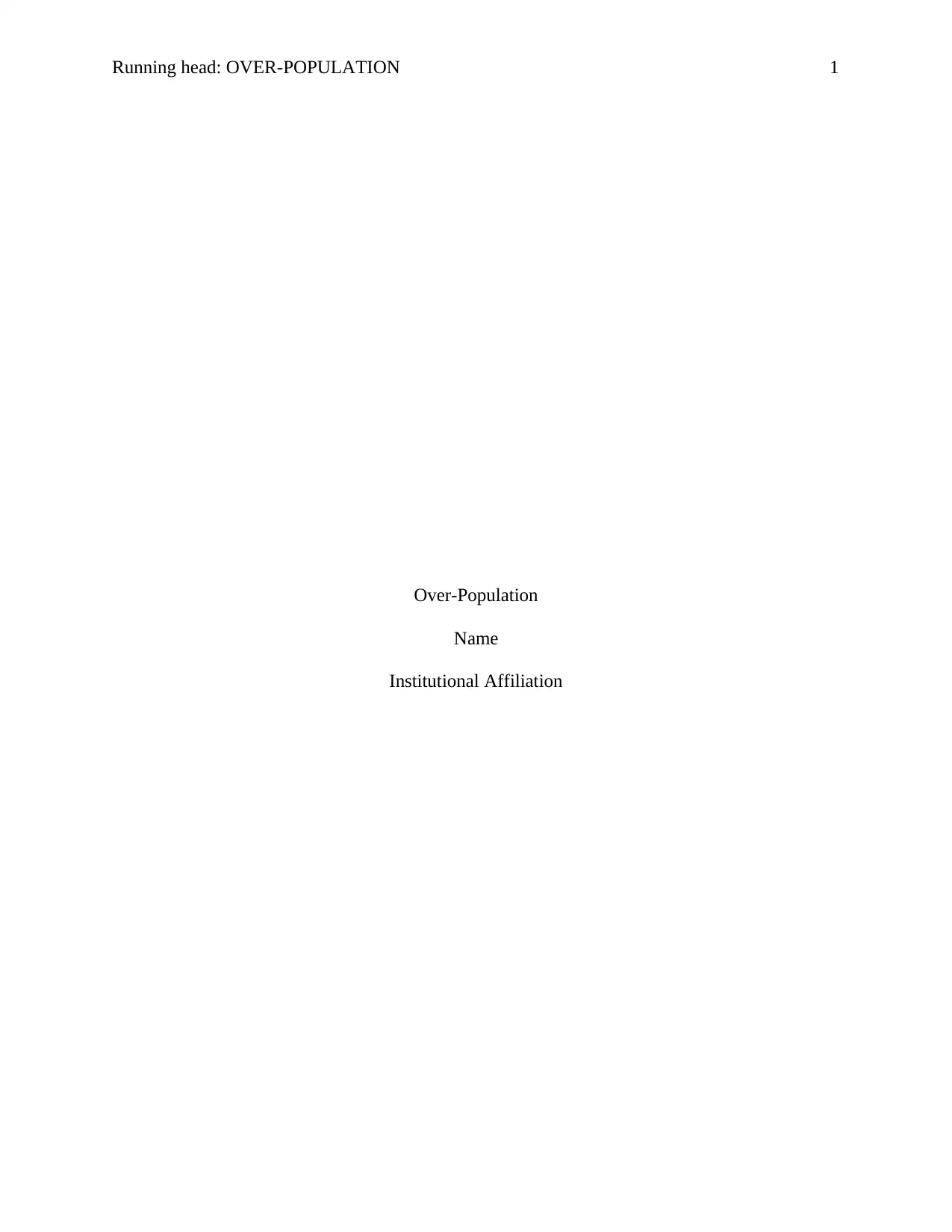
Running head: OVER-POPULATION 1
Over-Population
Name
Institutional Affiliation
Over-Population
Name
Institutional Affiliation
Secure Best Marks with AI Grader
Need help grading? Try our AI Grader for instant feedback on your assignments.
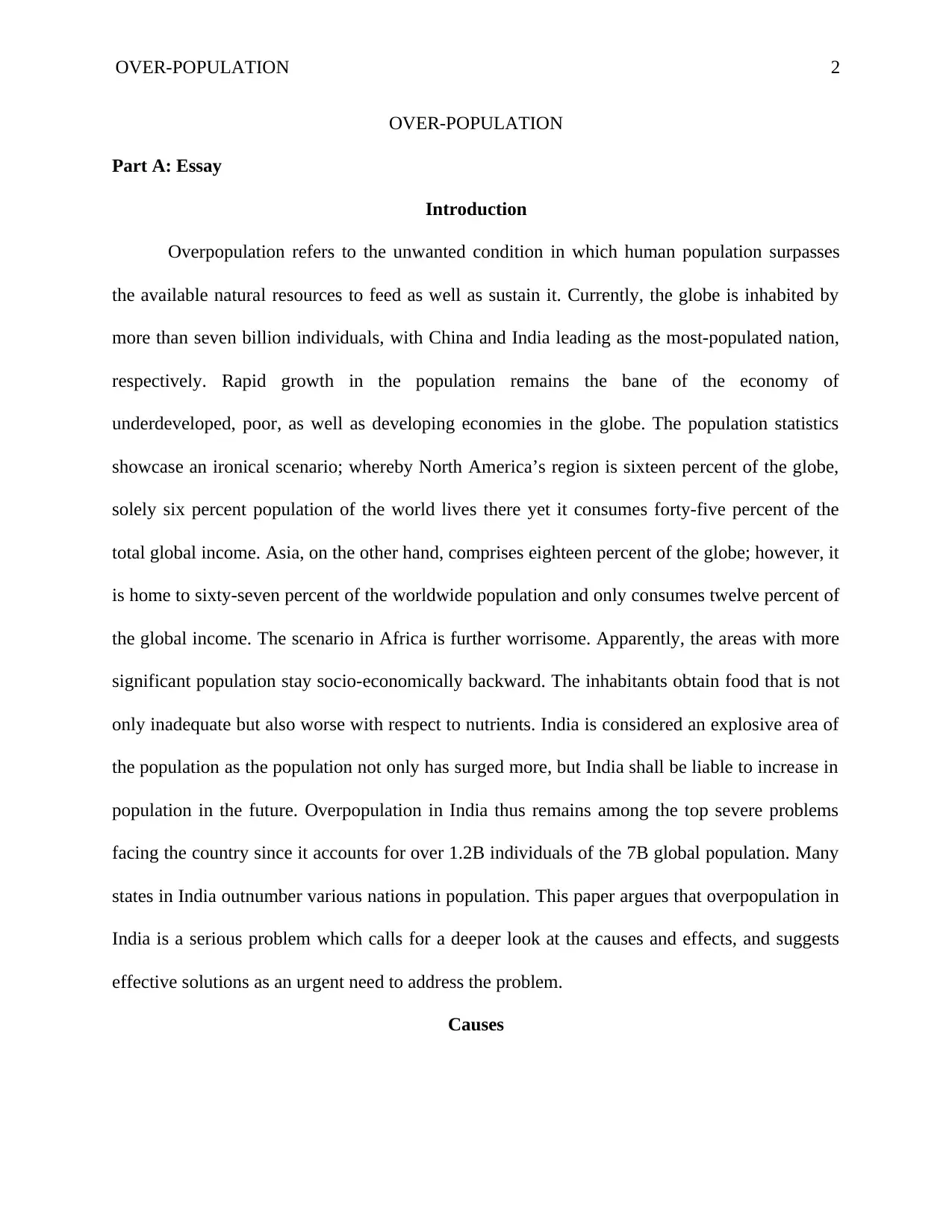
OVER-POPULATION 2
OVER-POPULATION
Part A: Essay
Introduction
Overpopulation refers to the unwanted condition in which human population surpasses
the available natural resources to feed as well as sustain it. Currently, the globe is inhabited by
more than seven billion individuals, with China and India leading as the most-populated nation,
respectively. Rapid growth in the population remains the bane of the economy of
underdeveloped, poor, as well as developing economies in the globe. The population statistics
showcase an ironical scenario; whereby North America’s region is sixteen percent of the globe,
solely six percent population of the world lives there yet it consumes forty-five percent of the
total global income. Asia, on the other hand, comprises eighteen percent of the globe; however, it
is home to sixty-seven percent of the worldwide population and only consumes twelve percent of
the global income. The scenario in Africa is further worrisome. Apparently, the areas with more
significant population stay socio-economically backward. The inhabitants obtain food that is not
only inadequate but also worse with respect to nutrients. India is considered an explosive area of
the population as the population not only has surged more, but India shall be liable to increase in
population in the future. Overpopulation in India thus remains among the top severe problems
facing the country since it accounts for over 1.2B individuals of the 7B global population. Many
states in India outnumber various nations in population. This paper argues that overpopulation in
India is a serious problem which calls for a deeper look at the causes and effects, and suggests
effective solutions as an urgent need to address the problem.
Causes
OVER-POPULATION
Part A: Essay
Introduction
Overpopulation refers to the unwanted condition in which human population surpasses
the available natural resources to feed as well as sustain it. Currently, the globe is inhabited by
more than seven billion individuals, with China and India leading as the most-populated nation,
respectively. Rapid growth in the population remains the bane of the economy of
underdeveloped, poor, as well as developing economies in the globe. The population statistics
showcase an ironical scenario; whereby North America’s region is sixteen percent of the globe,
solely six percent population of the world lives there yet it consumes forty-five percent of the
total global income. Asia, on the other hand, comprises eighteen percent of the globe; however, it
is home to sixty-seven percent of the worldwide population and only consumes twelve percent of
the global income. The scenario in Africa is further worrisome. Apparently, the areas with more
significant population stay socio-economically backward. The inhabitants obtain food that is not
only inadequate but also worse with respect to nutrients. India is considered an explosive area of
the population as the population not only has surged more, but India shall be liable to increase in
population in the future. Overpopulation in India thus remains among the top severe problems
facing the country since it accounts for over 1.2B individuals of the 7B global population. Many
states in India outnumber various nations in population. This paper argues that overpopulation in
India is a serious problem which calls for a deeper look at the causes and effects, and suggests
effective solutions as an urgent need to address the problem.
Causes
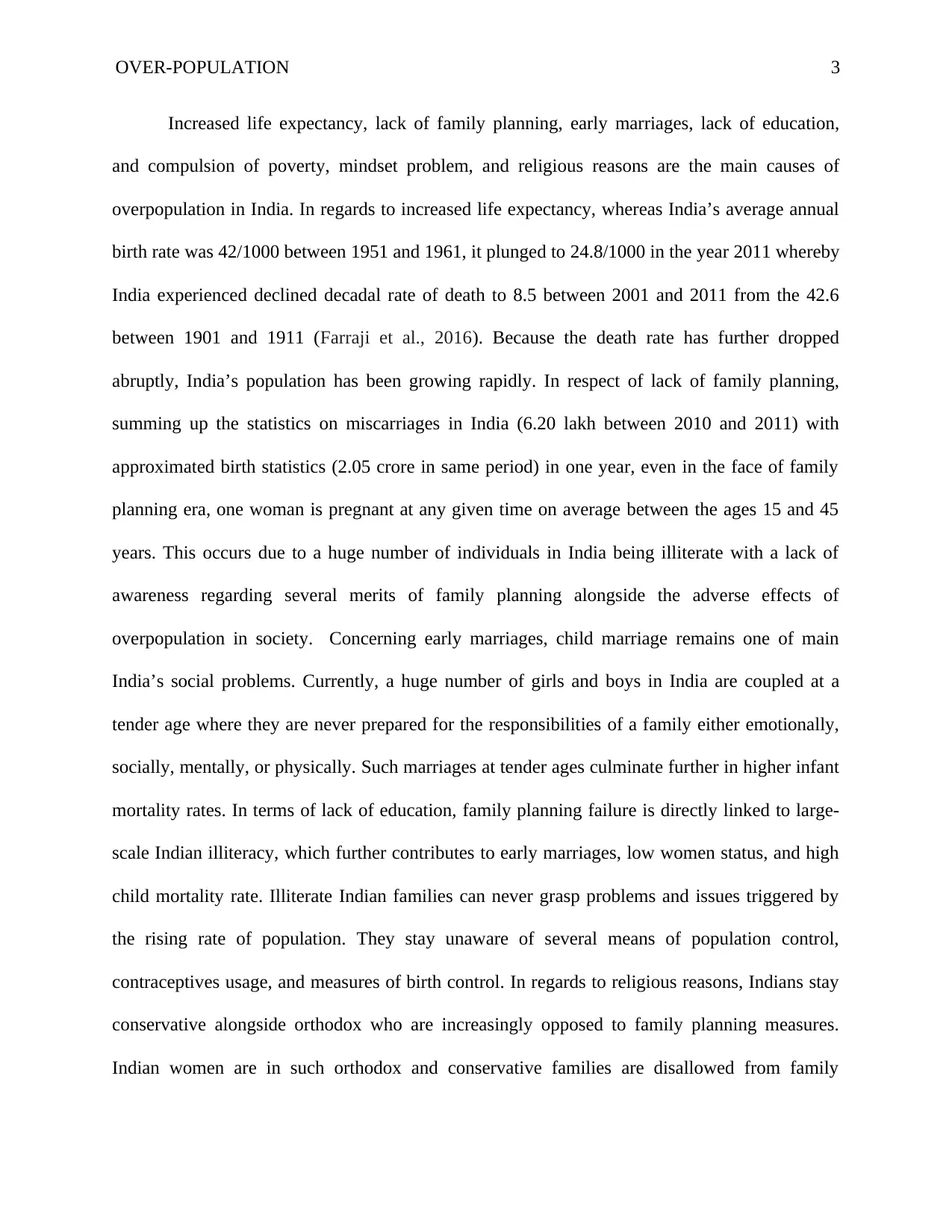
OVER-POPULATION 3
Increased life expectancy, lack of family planning, early marriages, lack of education,
and compulsion of poverty, mindset problem, and religious reasons are the main causes of
overpopulation in India. In regards to increased life expectancy, whereas India’s average annual
birth rate was 42/1000 between 1951 and 1961, it plunged to 24.8/1000 in the year 2011 whereby
India experienced declined decadal rate of death to 8.5 between 2001 and 2011 from the 42.6
between 1901 and 1911 (Farraji et al., 2016). Because the death rate has further dropped
abruptly, India’s population has been growing rapidly. In respect of lack of family planning,
summing up the statistics on miscarriages in India (6.20 lakh between 2010 and 2011) with
approximated birth statistics (2.05 crore in same period) in one year, even in the face of family
planning era, one woman is pregnant at any given time on average between the ages 15 and 45
years. This occurs due to a huge number of individuals in India being illiterate with a lack of
awareness regarding several merits of family planning alongside the adverse effects of
overpopulation in society. Concerning early marriages, child marriage remains one of main
India’s social problems. Currently, a huge number of girls and boys in India are coupled at a
tender age where they are never prepared for the responsibilities of a family either emotionally,
socially, mentally, or physically. Such marriages at tender ages culminate further in higher infant
mortality rates. In terms of lack of education, family planning failure is directly linked to large-
scale Indian illiteracy, which further contributes to early marriages, low women status, and high
child mortality rate. Illiterate Indian families can never grasp problems and issues triggered by
the rising rate of population. They stay unaware of several means of population control,
contraceptives usage, and measures of birth control. In regards to religious reasons, Indians stay
conservative alongside orthodox who are increasingly opposed to family planning measures.
Indian women are in such orthodox and conservative families are disallowed from family
Increased life expectancy, lack of family planning, early marriages, lack of education,
and compulsion of poverty, mindset problem, and religious reasons are the main causes of
overpopulation in India. In regards to increased life expectancy, whereas India’s average annual
birth rate was 42/1000 between 1951 and 1961, it plunged to 24.8/1000 in the year 2011 whereby
India experienced declined decadal rate of death to 8.5 between 2001 and 2011 from the 42.6
between 1901 and 1911 (Farraji et al., 2016). Because the death rate has further dropped
abruptly, India’s population has been growing rapidly. In respect of lack of family planning,
summing up the statistics on miscarriages in India (6.20 lakh between 2010 and 2011) with
approximated birth statistics (2.05 crore in same period) in one year, even in the face of family
planning era, one woman is pregnant at any given time on average between the ages 15 and 45
years. This occurs due to a huge number of individuals in India being illiterate with a lack of
awareness regarding several merits of family planning alongside the adverse effects of
overpopulation in society. Concerning early marriages, child marriage remains one of main
India’s social problems. Currently, a huge number of girls and boys in India are coupled at a
tender age where they are never prepared for the responsibilities of a family either emotionally,
socially, mentally, or physically. Such marriages at tender ages culminate further in higher infant
mortality rates. In terms of lack of education, family planning failure is directly linked to large-
scale Indian illiteracy, which further contributes to early marriages, low women status, and high
child mortality rate. Illiterate Indian families can never grasp problems and issues triggered by
the rising rate of population. They stay unaware of several means of population control,
contraceptives usage, and measures of birth control. In regards to religious reasons, Indians stay
conservative alongside orthodox who are increasingly opposed to family planning measures.
Indian women are in such orthodox and conservative families are disallowed from family
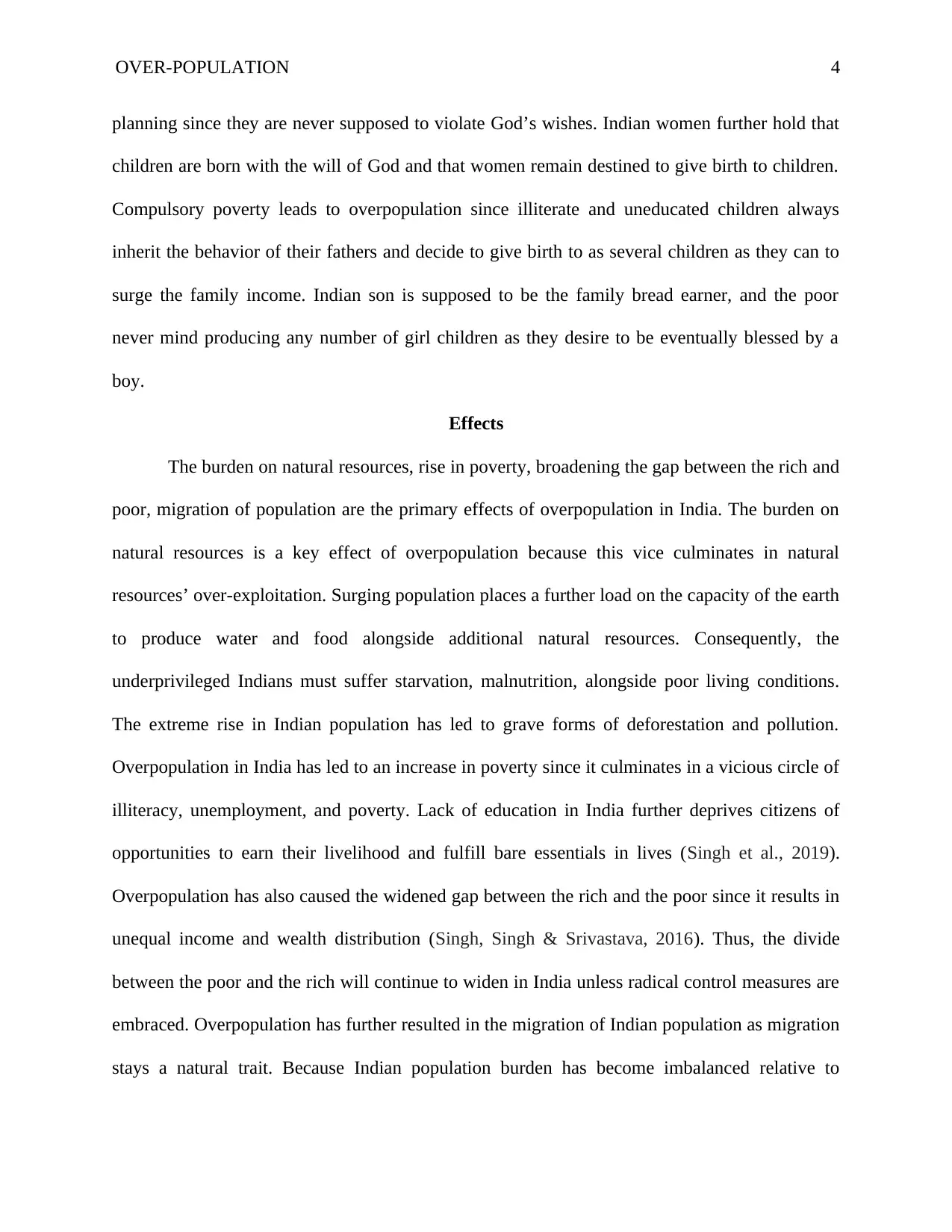
OVER-POPULATION 4
planning since they are never supposed to violate God’s wishes. Indian women further hold that
children are born with the will of God and that women remain destined to give birth to children.
Compulsory poverty leads to overpopulation since illiterate and uneducated children always
inherit the behavior of their fathers and decide to give birth to as several children as they can to
surge the family income. Indian son is supposed to be the family bread earner, and the poor
never mind producing any number of girl children as they desire to be eventually blessed by a
boy.
Effects
The burden on natural resources, rise in poverty, broadening the gap between the rich and
poor, migration of population are the primary effects of overpopulation in India. The burden on
natural resources is a key effect of overpopulation because this vice culminates in natural
resources’ over-exploitation. Surging population places a further load on the capacity of the earth
to produce water and food alongside additional natural resources. Consequently, the
underprivileged Indians must suffer starvation, malnutrition, alongside poor living conditions.
The extreme rise in Indian population has led to grave forms of deforestation and pollution.
Overpopulation in India has led to an increase in poverty since it culminates in a vicious circle of
illiteracy, unemployment, and poverty. Lack of education in India further deprives citizens of
opportunities to earn their livelihood and fulfill bare essentials in lives (Singh et al., 2019).
Overpopulation has also caused the widened gap between the rich and the poor since it results in
unequal income and wealth distribution (Singh, Singh & Srivastava, 2016). Thus, the divide
between the poor and the rich will continue to widen in India unless radical control measures are
embraced. Overpopulation has further resulted in the migration of Indian population as migration
stays a natural trait. Because Indian population burden has become imbalanced relative to
planning since they are never supposed to violate God’s wishes. Indian women further hold that
children are born with the will of God and that women remain destined to give birth to children.
Compulsory poverty leads to overpopulation since illiterate and uneducated children always
inherit the behavior of their fathers and decide to give birth to as several children as they can to
surge the family income. Indian son is supposed to be the family bread earner, and the poor
never mind producing any number of girl children as they desire to be eventually blessed by a
boy.
Effects
The burden on natural resources, rise in poverty, broadening the gap between the rich and
poor, migration of population are the primary effects of overpopulation in India. The burden on
natural resources is a key effect of overpopulation because this vice culminates in natural
resources’ over-exploitation. Surging population places a further load on the capacity of the earth
to produce water and food alongside additional natural resources. Consequently, the
underprivileged Indians must suffer starvation, malnutrition, alongside poor living conditions.
The extreme rise in Indian population has led to grave forms of deforestation and pollution.
Overpopulation in India has led to an increase in poverty since it culminates in a vicious circle of
illiteracy, unemployment, and poverty. Lack of education in India further deprives citizens of
opportunities to earn their livelihood and fulfill bare essentials in lives (Singh et al., 2019).
Overpopulation has also caused the widened gap between the rich and the poor since it results in
unequal income and wealth distribution (Singh, Singh & Srivastava, 2016). Thus, the divide
between the poor and the rich will continue to widen in India unless radical control measures are
embraced. Overpopulation has further resulted in the migration of Indian population as migration
stays a natural trait. Because Indian population burden has become imbalanced relative to
Secure Best Marks with AI Grader
Need help grading? Try our AI Grader for instant feedback on your assignments.
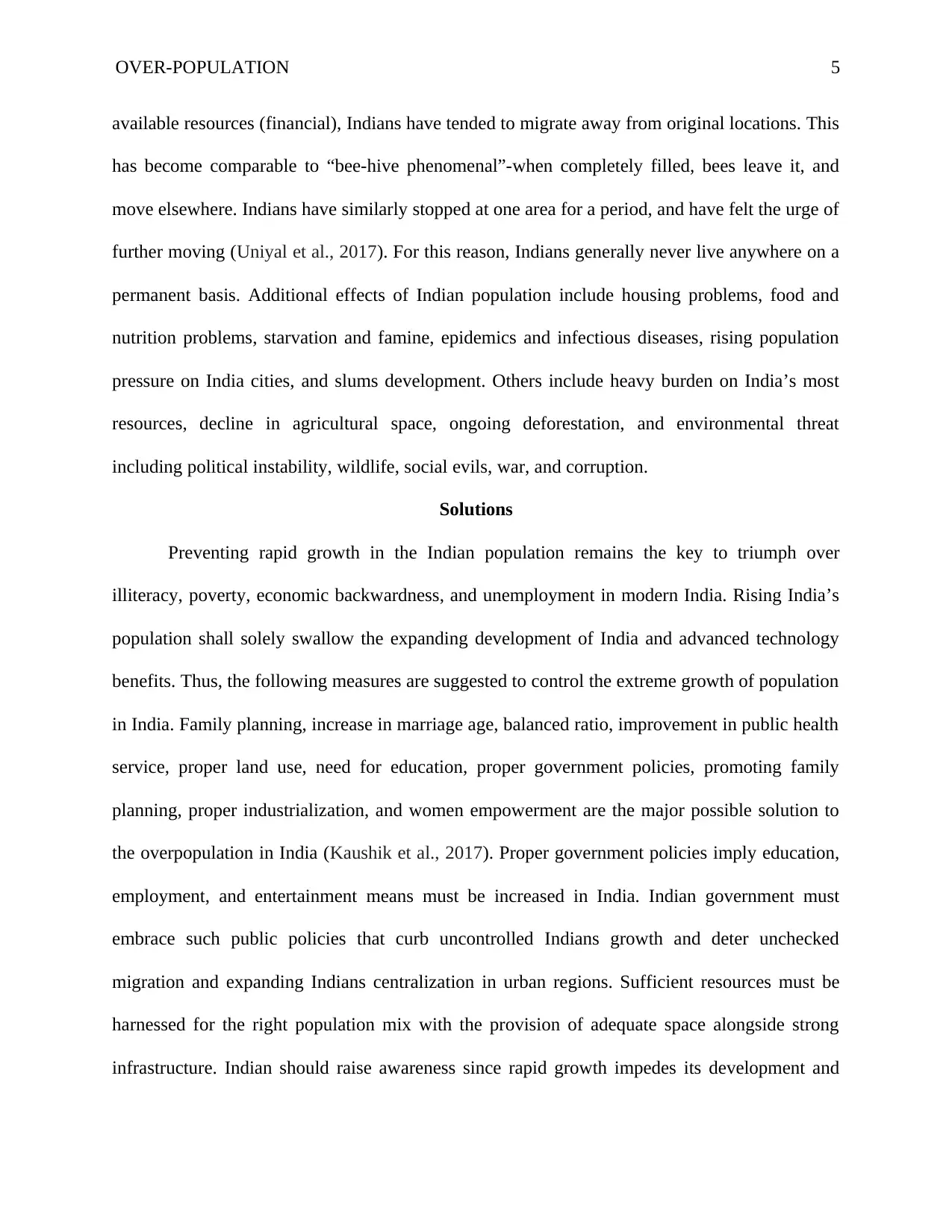
OVER-POPULATION 5
available resources (financial), Indians have tended to migrate away from original locations. This
has become comparable to “bee-hive phenomenal”-when completely filled, bees leave it, and
move elsewhere. Indians have similarly stopped at one area for a period, and have felt the urge of
further moving (Uniyal et al., 2017). For this reason, Indians generally never live anywhere on a
permanent basis. Additional effects of Indian population include housing problems, food and
nutrition problems, starvation and famine, epidemics and infectious diseases, rising population
pressure on India cities, and slums development. Others include heavy burden on India’s most
resources, decline in agricultural space, ongoing deforestation, and environmental threat
including political instability, wildlife, social evils, war, and corruption.
Solutions
Preventing rapid growth in the Indian population remains the key to triumph over
illiteracy, poverty, economic backwardness, and unemployment in modern India. Rising India’s
population shall solely swallow the expanding development of India and advanced technology
benefits. Thus, the following measures are suggested to control the extreme growth of population
in India. Family planning, increase in marriage age, balanced ratio, improvement in public health
service, proper land use, need for education, proper government policies, promoting family
planning, proper industrialization, and women empowerment are the major possible solution to
the overpopulation in India (Kaushik et al., 2017). Proper government policies imply education,
employment, and entertainment means must be increased in India. Indian government must
embrace such public policies that curb uncontrolled Indians growth and deter unchecked
migration and expanding Indians centralization in urban regions. Sufficient resources must be
harnessed for the right population mix with the provision of adequate space alongside strong
infrastructure. Indian should raise awareness since rapid growth impedes its development and
available resources (financial), Indians have tended to migrate away from original locations. This
has become comparable to “bee-hive phenomenal”-when completely filled, bees leave it, and
move elsewhere. Indians have similarly stopped at one area for a period, and have felt the urge of
further moving (Uniyal et al., 2017). For this reason, Indians generally never live anywhere on a
permanent basis. Additional effects of Indian population include housing problems, food and
nutrition problems, starvation and famine, epidemics and infectious diseases, rising population
pressure on India cities, and slums development. Others include heavy burden on India’s most
resources, decline in agricultural space, ongoing deforestation, and environmental threat
including political instability, wildlife, social evils, war, and corruption.
Solutions
Preventing rapid growth in the Indian population remains the key to triumph over
illiteracy, poverty, economic backwardness, and unemployment in modern India. Rising India’s
population shall solely swallow the expanding development of India and advanced technology
benefits. Thus, the following measures are suggested to control the extreme growth of population
in India. Family planning, increase in marriage age, balanced ratio, improvement in public health
service, proper land use, need for education, proper government policies, promoting family
planning, proper industrialization, and women empowerment are the major possible solution to
the overpopulation in India (Kaushik et al., 2017). Proper government policies imply education,
employment, and entertainment means must be increased in India. Indian government must
embrace such public policies that curb uncontrolled Indians growth and deter unchecked
migration and expanding Indians centralization in urban regions. Sufficient resources must be
harnessed for the right population mix with the provision of adequate space alongside strong
infrastructure. Indian should raise awareness since rapid growth impedes its development and
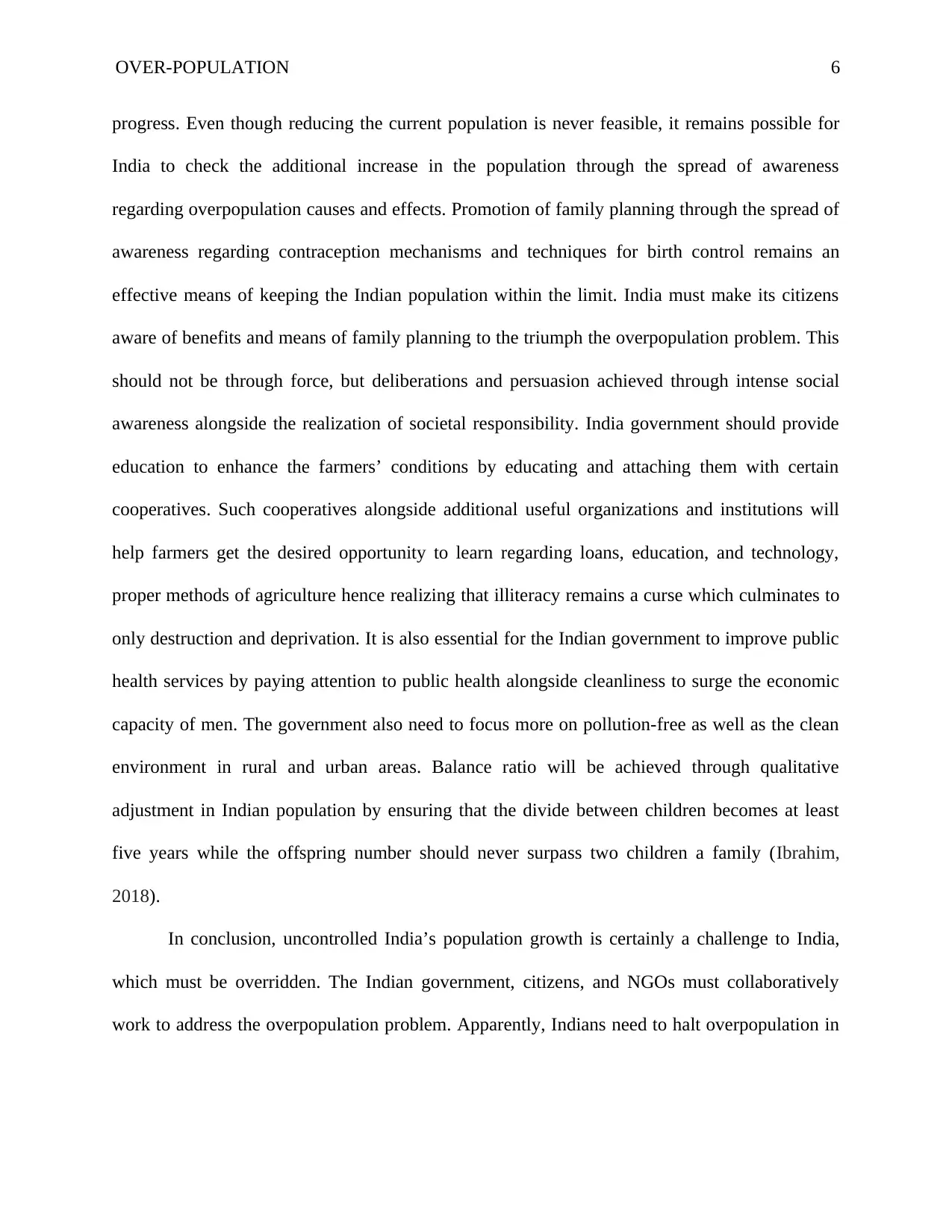
OVER-POPULATION 6
progress. Even though reducing the current population is never feasible, it remains possible for
India to check the additional increase in the population through the spread of awareness
regarding overpopulation causes and effects. Promotion of family planning through the spread of
awareness regarding contraception mechanisms and techniques for birth control remains an
effective means of keeping the Indian population within the limit. India must make its citizens
aware of benefits and means of family planning to the triumph the overpopulation problem. This
should not be through force, but deliberations and persuasion achieved through intense social
awareness alongside the realization of societal responsibility. India government should provide
education to enhance the farmers’ conditions by educating and attaching them with certain
cooperatives. Such cooperatives alongside additional useful organizations and institutions will
help farmers get the desired opportunity to learn regarding loans, education, and technology,
proper methods of agriculture hence realizing that illiteracy remains a curse which culminates to
only destruction and deprivation. It is also essential for the Indian government to improve public
health services by paying attention to public health alongside cleanliness to surge the economic
capacity of men. The government also need to focus more on pollution-free as well as the clean
environment in rural and urban areas. Balance ratio will be achieved through qualitative
adjustment in Indian population by ensuring that the divide between children becomes at least
five years while the offspring number should never surpass two children a family (Ibrahim,
2018).
In conclusion, uncontrolled India’s population growth is certainly a challenge to India,
which must be overridden. The Indian government, citizens, and NGOs must collaboratively
work to address the overpopulation problem. Apparently, Indians need to halt overpopulation in
progress. Even though reducing the current population is never feasible, it remains possible for
India to check the additional increase in the population through the spread of awareness
regarding overpopulation causes and effects. Promotion of family planning through the spread of
awareness regarding contraception mechanisms and techniques for birth control remains an
effective means of keeping the Indian population within the limit. India must make its citizens
aware of benefits and means of family planning to the triumph the overpopulation problem. This
should not be through force, but deliberations and persuasion achieved through intense social
awareness alongside the realization of societal responsibility. India government should provide
education to enhance the farmers’ conditions by educating and attaching them with certain
cooperatives. Such cooperatives alongside additional useful organizations and institutions will
help farmers get the desired opportunity to learn regarding loans, education, and technology,
proper methods of agriculture hence realizing that illiteracy remains a curse which culminates to
only destruction and deprivation. It is also essential for the Indian government to improve public
health services by paying attention to public health alongside cleanliness to surge the economic
capacity of men. The government also need to focus more on pollution-free as well as the clean
environment in rural and urban areas. Balance ratio will be achieved through qualitative
adjustment in Indian population by ensuring that the divide between children becomes at least
five years while the offspring number should never surpass two children a family (Ibrahim,
2018).
In conclusion, uncontrolled India’s population growth is certainly a challenge to India,
which must be overridden. The Indian government, citizens, and NGOs must collaboratively
work to address the overpopulation problem. Apparently, Indians need to halt overpopulation in
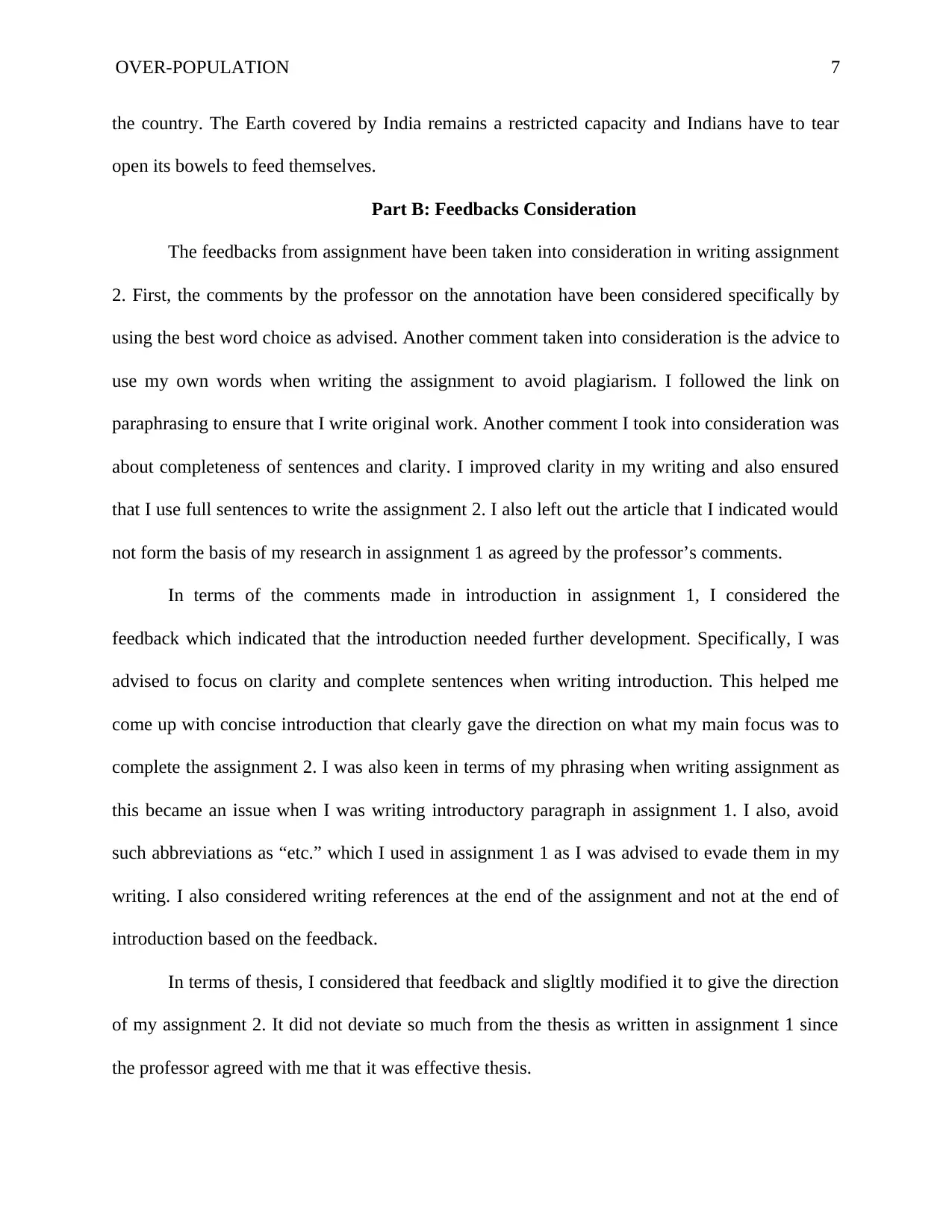
OVER-POPULATION 7
the country. The Earth covered by India remains a restricted capacity and Indians have to tear
open its bowels to feed themselves.
Part B: Feedbacks Consideration
The feedbacks from assignment have been taken into consideration in writing assignment
2. First, the comments by the professor on the annotation have been considered specifically by
using the best word choice as advised. Another comment taken into consideration is the advice to
use my own words when writing the assignment to avoid plagiarism. I followed the link on
paraphrasing to ensure that I write original work. Another comment I took into consideration was
about completeness of sentences and clarity. I improved clarity in my writing and also ensured
that I use full sentences to write the assignment 2. I also left out the article that I indicated would
not form the basis of my research in assignment 1 as agreed by the professor’s comments.
In terms of the comments made in introduction in assignment 1, I considered the
feedback which indicated that the introduction needed further development. Specifically, I was
advised to focus on clarity and complete sentences when writing introduction. This helped me
come up with concise introduction that clearly gave the direction on what my main focus was to
complete the assignment 2. I was also keen in terms of my phrasing when writing assignment as
this became an issue when I was writing introductory paragraph in assignment 1. I also, avoid
such abbreviations as “etc.” which I used in assignment 1 as I was advised to evade them in my
writing. I also considered writing references at the end of the assignment and not at the end of
introduction based on the feedback.
In terms of thesis, I considered that feedback and sligltly modified it to give the direction
of my assignment 2. It did not deviate so much from the thesis as written in assignment 1 since
the professor agreed with me that it was effective thesis.
the country. The Earth covered by India remains a restricted capacity and Indians have to tear
open its bowels to feed themselves.
Part B: Feedbacks Consideration
The feedbacks from assignment have been taken into consideration in writing assignment
2. First, the comments by the professor on the annotation have been considered specifically by
using the best word choice as advised. Another comment taken into consideration is the advice to
use my own words when writing the assignment to avoid plagiarism. I followed the link on
paraphrasing to ensure that I write original work. Another comment I took into consideration was
about completeness of sentences and clarity. I improved clarity in my writing and also ensured
that I use full sentences to write the assignment 2. I also left out the article that I indicated would
not form the basis of my research in assignment 1 as agreed by the professor’s comments.
In terms of the comments made in introduction in assignment 1, I considered the
feedback which indicated that the introduction needed further development. Specifically, I was
advised to focus on clarity and complete sentences when writing introduction. This helped me
come up with concise introduction that clearly gave the direction on what my main focus was to
complete the assignment 2. I was also keen in terms of my phrasing when writing assignment as
this became an issue when I was writing introductory paragraph in assignment 1. I also, avoid
such abbreviations as “etc.” which I used in assignment 1 as I was advised to evade them in my
writing. I also considered writing references at the end of the assignment and not at the end of
introduction based on the feedback.
In terms of thesis, I considered that feedback and sligltly modified it to give the direction
of my assignment 2. It did not deviate so much from the thesis as written in assignment 1 since
the professor agreed with me that it was effective thesis.
Paraphrase This Document
Need a fresh take? Get an instant paraphrase of this document with our AI Paraphraser
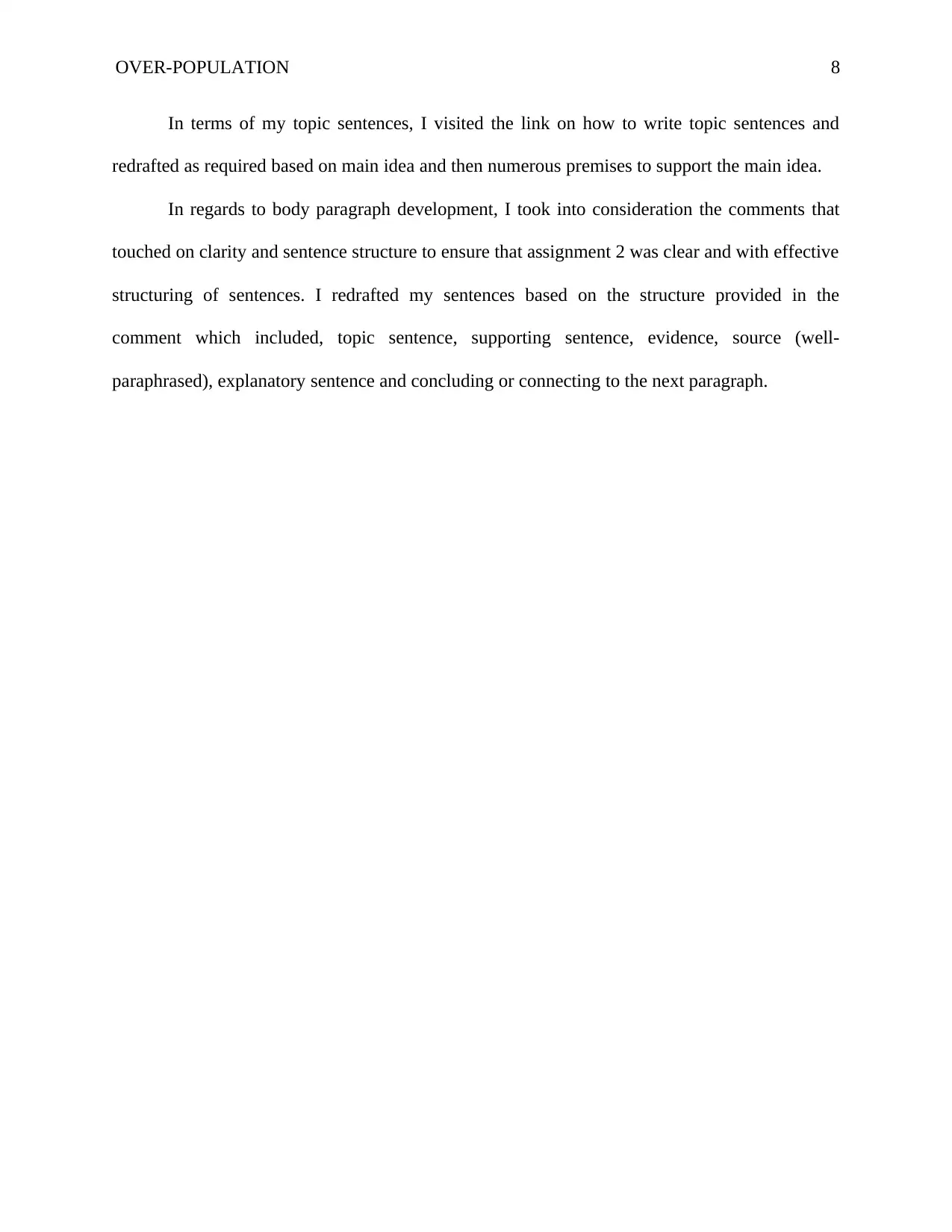
OVER-POPULATION 8
In terms of my topic sentences, I visited the link on how to write topic sentences and
redrafted as required based on main idea and then numerous premises to support the main idea.
In regards to body paragraph development, I took into consideration the comments that
touched on clarity and sentence structure to ensure that assignment 2 was clear and with effective
structuring of sentences. I redrafted my sentences based on the structure provided in the
comment which included, topic sentence, supporting sentence, evidence, source (well-
paraphrased), explanatory sentence and concluding or connecting to the next paragraph.
In terms of my topic sentences, I visited the link on how to write topic sentences and
redrafted as required based on main idea and then numerous premises to support the main idea.
In regards to body paragraph development, I took into consideration the comments that
touched on clarity and sentence structure to ensure that assignment 2 was clear and with effective
structuring of sentences. I redrafted my sentences based on the structure provided in the
comment which included, topic sentence, supporting sentence, evidence, source (well-
paraphrased), explanatory sentence and concluding or connecting to the next paragraph.
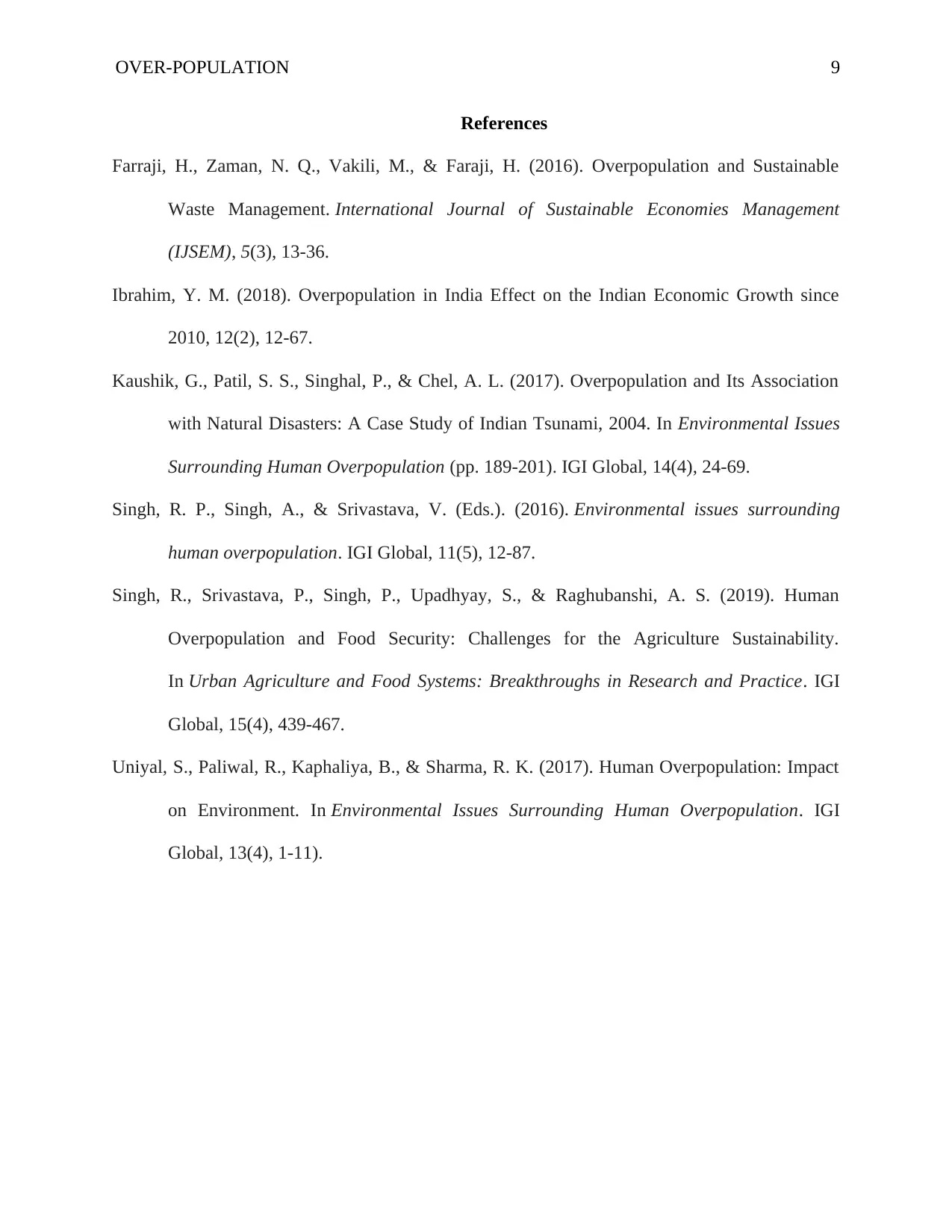
OVER-POPULATION 9
References
Farraji, H., Zaman, N. Q., Vakili, M., & Faraji, H. (2016). Overpopulation and Sustainable
Waste Management. International Journal of Sustainable Economies Management
(IJSEM), 5(3), 13-36.
Ibrahim, Y. M. (2018). Overpopulation in India Effect on the Indian Economic Growth since
2010, 12(2), 12-67.
Kaushik, G., Patil, S. S., Singhal, P., & Chel, A. L. (2017). Overpopulation and Its Association
with Natural Disasters: A Case Study of Indian Tsunami, 2004. In Environmental Issues
Surrounding Human Overpopulation (pp. 189-201). IGI Global, 14(4), 24-69.
Singh, R. P., Singh, A., & Srivastava, V. (Eds.). (2016). Environmental issues surrounding
human overpopulation. IGI Global, 11(5), 12-87.
Singh, R., Srivastava, P., Singh, P., Upadhyay, S., & Raghubanshi, A. S. (2019). Human
Overpopulation and Food Security: Challenges for the Agriculture Sustainability.
In Urban Agriculture and Food Systems: Breakthroughs in Research and Practice. IGI
Global, 15(4), 439-467.
Uniyal, S., Paliwal, R., Kaphaliya, B., & Sharma, R. K. (2017). Human Overpopulation: Impact
on Environment. In Environmental Issues Surrounding Human Overpopulation. IGI
Global, 13(4), 1-11).
References
Farraji, H., Zaman, N. Q., Vakili, M., & Faraji, H. (2016). Overpopulation and Sustainable
Waste Management. International Journal of Sustainable Economies Management
(IJSEM), 5(3), 13-36.
Ibrahim, Y. M. (2018). Overpopulation in India Effect on the Indian Economic Growth since
2010, 12(2), 12-67.
Kaushik, G., Patil, S. S., Singhal, P., & Chel, A. L. (2017). Overpopulation and Its Association
with Natural Disasters: A Case Study of Indian Tsunami, 2004. In Environmental Issues
Surrounding Human Overpopulation (pp. 189-201). IGI Global, 14(4), 24-69.
Singh, R. P., Singh, A., & Srivastava, V. (Eds.). (2016). Environmental issues surrounding
human overpopulation. IGI Global, 11(5), 12-87.
Singh, R., Srivastava, P., Singh, P., Upadhyay, S., & Raghubanshi, A. S. (2019). Human
Overpopulation and Food Security: Challenges for the Agriculture Sustainability.
In Urban Agriculture and Food Systems: Breakthroughs in Research and Practice. IGI
Global, 15(4), 439-467.
Uniyal, S., Paliwal, R., Kaphaliya, B., & Sharma, R. K. (2017). Human Overpopulation: Impact
on Environment. In Environmental Issues Surrounding Human Overpopulation. IGI
Global, 13(4), 1-11).
1 out of 9
Related Documents
Your All-in-One AI-Powered Toolkit for Academic Success.
+13062052269
info@desklib.com
Available 24*7 on WhatsApp / Email
![[object Object]](/_next/static/media/star-bottom.7253800d.svg)
Unlock your academic potential
© 2024 | Zucol Services PVT LTD | All rights reserved.



